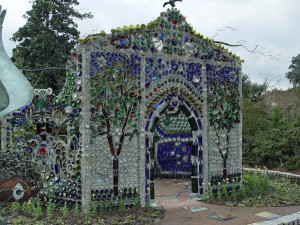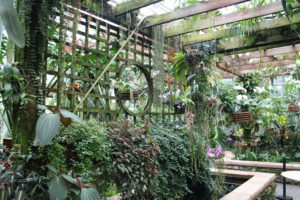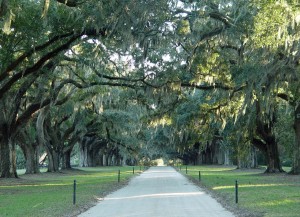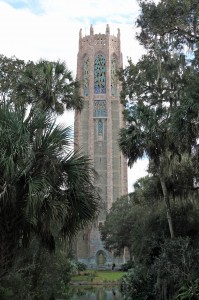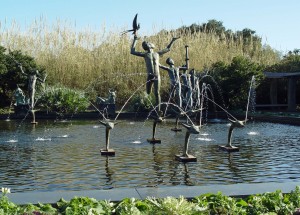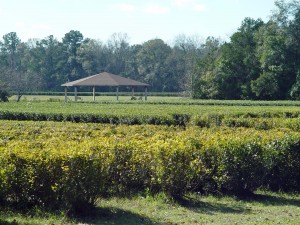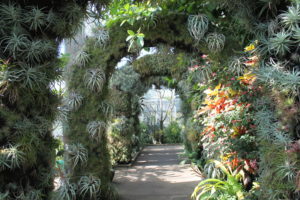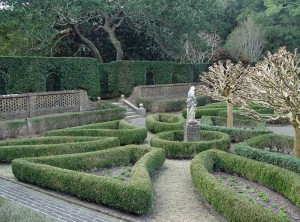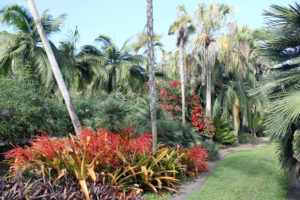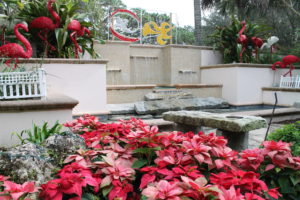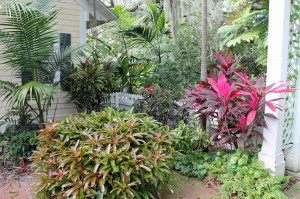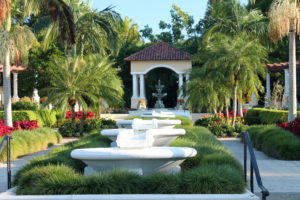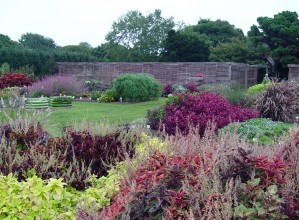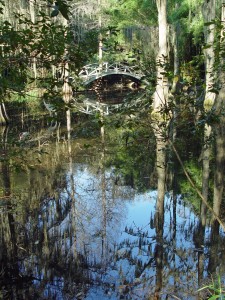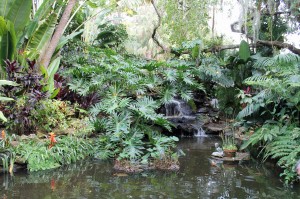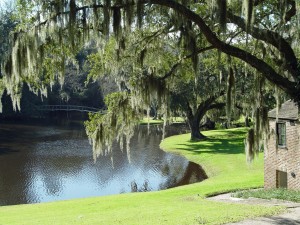U.S. South
These are gardens I’ve been to in the U.S. South that I believe are worth a visit. I’d highly advise double-checking on hours before visiting since not all are open every day or year round.
AIRLIE GARDENS
Location: 300 Airlie Road, Wilmington, N.C.
Overview: Got its start as the estate of Pembroke and Sarah Jones, who entertained lavishly in the early 1920s and planted half a million azaleas, 5,000 camellias and many specimen trees. Now operated by New Hanover County, it’s transformed into a small but nice public garden.
Highlights: The signature piece is a replica of a chapel that’s made out of multi-colored glass bottles. Unique and hard to do justice by word. Besides azaleas and camellias, there are seasonal flower beds, a more formal pergola garden and the “Airlie Oak,” a live oak dating to the mid-1500s.
George’s Take: A good effort so far, but with 67 acres to work with, there’s a ton of potential if the investment can be made. It’s prime when the azaleas are in bloom (April).
Contact info: www.airliegardens.org. 910-798-7700.
ATLANTA BOTANICAL GARDEN
Location: 1345 Piedmont Ave. in midtown Atlanta, next to city’s large Piedmont Park.
Overview: Dating to 1976, the garden’s 30 acres fan out into several themed areas and straddle a road. It feels bigger, especially when you consider the winding walk through the wooded area. Closed Mondays, but check hours before going.
Highlights: Main claim to fame is the biggest botanic-garden permanent display of orchids (in the Fuqua Orchid Center). Conservatory is spacious and filled with unusual specimens. Excellent 2-acre Children’s Garden with climbing apparatus and water features, an innovative edible garden with outdoor cooking-demo kitchen, visitor center with a green roof, a canopy walk through the treetops, a huge cascading water feature with a two-story Mosaiculture earth-goddess statue, a rose garden, a Japanese garden, a fragrance garden and more. Top-notch restaurant here, too, plus a wonderful Christmas light display.
George’s Take: Well done and a nice mix of formal, informal, tropicals and edibles. Something for everyone. Two favorites here: the plenty-to-do, burn-the-kid-calories Children’s Garden and that signature goddess statue by the water cascades.
Contact info: http://atlantabg.org 404-876-5859
BOONE HALL PLANTATION AND GARDENS
Location: 1235 Long Point Road, Mt. Pleasant, S.C., near Charleston.
Overview: Still a working plantation after 320 years, growing fruits and vegetables for its own market on nearby Route 17 instead of the cotton and pecans of yesteryear. Owned since 1955 by McRae family, who opened it to give visitors a taste of 1800s plantation life.
Highlights: Signature is ¾-mile allee of live oaks lining entry drive. Very nice network of butterfly-shaped beds on either side of spacious front yard, tram tours of fields and Black History educational exhibits in each of nine original brick slave cabins.
George’s Take: The oaks are stunning, the Colonial-style front gardens are beautiful, but I was most touched by the stories told in the slave cabins. My favorite of the Charleston plantation gardens.
Contact info: www.boonehallplantation.com. 843-884-4371.
BOK TOWER GARDENS
Location: 1151 Tower Blvd., Lake Wales, Fla., about 50 miles southwest of Orlando.
Overview: 50 acres of mostly wooded tropical gardens, set on one of the highest ridges in Florida (a whopping 298 feet up!) Philadelphian and long-time Ladies Home Journal editor Edward Bok built these gardens (designed by Frederick Law Olmsted Jr.) at his winter home as a gift to the American people. The property now includes 8 acres called Pinetree Estates that was the retirement home (and excellent landscape) of Bethlehem Steel executive C. Austin Buck.
Highlights: The signature feature is the 205-foot carillon tower that Bok had built in the late 1920s at the top of the ridge, surrounded by a koi moat. The grounds are mostly shaded and excellent for strolling through the many palms, magnolias, camellias and live oaks dripping with Spanish moss. Pinetree Estates is more “landscapey” with somewhat more formal beds around the house, including an interesting allee of kumquat trees lining the front walk and clipped citrus trees in the front yard. See some pictures of Bok Tower in my Photo Gallery of Central Florida Gardens.
George’s Take: Peaceful is the word that comes to mind first here. It’s a great place to take a stroll, especially in the winter when you’d otherwise be freezing back home. The carillon is played most days and is well worth a listen. And this place is a haven for tropical birds.
Contact info: www.boktowergardens.org. 863-676-1408.
BROOKGREEN GARDENS
Location: U.S. Highway 17, about 30 minutes south of Myrtle Beach, S.C.
Overview: Philanthropist Archer Huntington and his sculptor wife, Anna Hyatt Huntington, pieced together four one-time rice plantations (nearly 10,000 acres in all) to create this superbly designed show place. It has the nation’s largest outdoor display of American-made figurative sculptures with more than 400 of them placed in beautiful gardens and natural settings throughout.
Highlights: Obviously, the sculptures – especially the larger-than-life bronze sculpture of Dionysus and the signature display “Fountain of the Muses,” with male figures running in unison over a pond of spouting fountains. Also stately 250-year live oaks, numerous formal water features, native plantings, a mirthful and colorful children’s garden and plenty of classic Southern plants, such as palmetto, camellia, crape myrtle, palms and magnolias. See some pictures of Brookgreen that are included in my Photo Gallery of Gardens of South Carolina.
George’s Take: This is way more than a sculpture garden. The layout and design is top rate with paths leading into room after room of awe. This is a world-class garden that hardly anyone knows about. It’s one of those places where I was saying, “Wow,” every 5 minutes. I’d rate it in my top dozen.
Contact info: www.brookgreen.org. 843-235-6000.
CHARLESTON TEA PLANTATION
Location: 6617 Maybank Highway, Wadmalaw Island, S.C., about 20 miles southwest of Charleston.
Overview: You’ll only find one plant on display here: Camellia sinensis, the plant that’s used to make tea. This is America’s only tea farm, and it’s got hundreds of thousands of camellias that are harvested to make American Classic Tea.
Highlights: Tour the on-site factory to see how tea is dried and processed, then hop on the tour bus for a guided drive through the fields. Not your typical garden tour, but it’s a fascinating plant story that most of us know little about. Right down the road is the “Angel Oak,” a native live oak that’s thought to be 1,400 years old and the oldest living thing east of the Mississippi. See some pictures of the tea plantation in my Photo Gallery of Gardens of South Carolina.
George’s Take: My wife especially loved this place. We take tea for granted and never give a thought to where it comes from. You’ll leave here wanting to grow your own camellias… and toting a bag of American Classic Tea from the gift shop.
Contact info: www.charlestonteaplantation.com. 843-559-0383.
DANIEL STOWE BOTANICAL GARDEN
Location: 6500 South New Hope Road, Belmont, N.C., about a half-hour southwest of Charlotte.
Overview: A young garden with an ambitious growth plan and 380 acres to work with. Land was donated in 1991 by retired textile executive Daniel J. Stowe. Beautiful Colonial-style visitor center (reminds me of Richmond’s Ginter Garden visitor center) with first 10 acres of gardens opened in 1999.
Highlights: It’s small but high-quality so far with the main highlight being the orchid conservatory with a tall waterfall as its centerpiece. The signature outdoor attraction is a 100-yard-long formal canal that’s planted with changing displays and capped at each end with water features. Also has a cottage garden, a conifer collection, a four-seasons garden, an azalea garden, a pollinator-friendly Scroll Garden, and lots of water features. Christmas light show is impressive.
George’s Take: Just getting started but the conservatory and canal garden are already worth a visit if you’re anywhere near. This will be a destination in its own right once they add the planned home-demo gardens, rose garden, Asian garden, lakeside entrance, trails and more.
Contact info: www.dsbg.org 704-825-4490
ELIZABETHAN GARDENS
Location: 1411 National Park Drive, Manteo, N.C., on Roanoke Island, within Fort Raleigh National Historic Site.
Overview: Set near where Sir Walter Raleigh’s “lost colony” landed in 1587, this 10-acre garden honors the time period with gardens planted in Elizabethan style. Planned and operated by the Garden Club of North Carolina.
Highlights: Beautiful sunken garden with sheared hollies, flower-filled parterres in the shape of bells and boats, pleached crape myrtles and a magnificent, antique Italian fountain in the center. Also a Shakespeare herb garden, a Queen’s Tea Garden with antique roses, a wooded walk with native plantings throughout and a live oak pre-dating the colonists’ landing.
George’s Take: This one was a pleasant surprise… better and more interesting than I anticipated. Not a huge place, but it’s nicely designed and a pleasant stroll. That sunken garden alone is worth the visit.
Contact info: www.elizabethangardens.org. 252-473-3234.
FAIRCHILD TROPICAL BOTANICAL GARDEN
Location: 10901 Old Cutler Road, Coral Gables, near Miami, Fla.
Overview: Founded in 1938 by a group of plant collectors and horticulturists in honor of famed plant explorer Dr. David Fairchild, who brought to the U.S. many of the plants in this tropical-leaning garden. 83 acres in all. Designed by the Frederik Law Olmsted firm’s William Lyman Phillips.
Highlights: America’s leading outdoor display of tropical trees and plants, especially palms and cycads. Also features tropical/subtropical orchids, a tropical fruit house, Florida native plants, bromeliads, tropical vines, a butterfly garden, an edible garden, and lots of lake views.
George’s Take: A nice place for a peaceful stroll through the tropics – especially in winter when Pennsylvania is freezing. I was most impressed with the palms, cycads and bougainvilleas here.
Contact info: www.fairchildgarden.org 305-667-1651
FLORIDA BOTANICAL GARDENS
Location: 12520 Ulmerton Road, Largo, Fla., just south of Clearwater on Florida’s Gulf Coast.
Overview: Run by Pinellas County and its Extension Service and Master Gardeners, this started out as an idea for a gardening learning center and morphed into a full-fledged botanical garden with 10 theme areas and 10,000 plants covering about 25 acres. Opened in 2000. Free admission.
Highlights: The Wedding Garden is a big draw and nicely done. The Tropical Walk is another signature attraction, and theme gardens are devoted to herbs, tropical fruits, succulents, Florida native plants, butterflies, palms and vines. The Patio Garden is a nice demonstration of a peaceful home-garden concept. Next door is the 21-acre Heritage Village, a living history area with 31 structures (homes, schools, churches, shops, etc.) that tell the story of the region’s past.
George’s Take: Master Gardeners and Extension Services often build interesting demo gardens, but I’ve never seen one of this scope and caliber anywhere else. It’s an excellent overview of the kinds of plants and gardens that thrive in Florida… colorful, educational and a day’s resource along with the adjoining Heritage Center.
Contact info: www.flbg.org 727-582-2100
HARRY P. LEU GARDENS
Location: 1920 N. Forest Ave., Orlando, Fla.
Overview: Harry and Mary Jane Leu were Orlando garden-lovers who built a wonderful home landscape over 50 acres. (Harry made a fortune in the construction supply business.) They donated the plant-filled estate to the city of Orlando in 1961, and the city has operated it as a public garden since.
Highlights: Most of the grounds are divided into themed areas – eastern America’s biggest camellia collection being the Gardens’ main claim to fame. But lots of interesting gardens dot the 50 acres, including Mary Jane’s Rose Garden, a citrus collection, a vegetable garden, a garden of arid plants, a butterfly garden and numerous “idea gardens.” Overall, it’s an excellent place to get a feel for gardening in Florida. See some pictures of Leu Gardens in my Photo Gallery of Central Florida Gardens.
George’s Take: This garden has a little of everything and plenty to keep a northern plant geek gawking at every turn. I liked the palms, cycads and camellias best. But it was very nice to see a whole formal bed full of roses blooming in January. This is a good place to start if you’ve never seen Florida gardening in action.
Contact info: www.leugardens.org. 407-246-2620.
HOLLIS GARDEN
Location: 702 E. Orange St. along Lake Mirror in Lakeland, Fla.
Overview: One of the nicest city-run gardens you’ll ever see. Set overlooking a large, oval city lake, it’s a small but formal terraced garden with lots of color, fountains and tropical plants. Funded by and made possible by a grant from Mark Hollis, the late president of the Lakeland-based Publix supermarket chain and his wife, Lynn. Closed Mondays. Free admission.
Highlights: A formal fountain with channel and bowls runs down the center from a grotto. Space is divided into rooms featuring different themes, such as fruits, herbs, Florida native plants, historic trees, and flowers by color. See some pictures of Hollis Garden in my Photo Gallery of Gardens of Central Florida.
George’s Take: Neat, clean, colorful and hard to believe this is offered by a city… and free to the public, too. I love the setting as much as the plants and Italianesque layout. Kudos to Lakeland on this gem.
Contact info: www.lakelandgov.net/parkrec/hollis-garden 863-834-2280
J.C. RAULSTON ARBORETUM
Location: 4415 Beryl Road, Raleigh, N.C.
Overview: Built and maintained by North Carolina State University, this has a ton of plant diversity packed into its 8 acres. It’s primarily a research and teaching garden with more than 5,000 species on display. Named after the late J.C. Raulston, an NC State professor who founded the arboretum in 1976.
Highlights: Most impressive are the 300-foot-long borders of perennials and mixed plantings – color and cutting-edge varieties as far as you can see. It’s also a site for trials of annual flowers (new ones every year) and has theme gardens such as a white garden, a rose garden, a xeric garden and an Asian valley, plus collections of maples, hollies, redbuds, nandina and more.
George’s Take: I’m a sucker for cutting-edge plants and the latest, greatest variety of just about anything, so this place was right up my alley. If you’re a stroller rather than a studier, you’ll think it’s just OK.
Contact info: www.ncsu.edu/jcraulstonarboretum. 919-515-3132.
MAGNOLIA PLANTATION AND GARDENS
Location: 3550 Ashley River Road, Charleston, S.C., about 9 miles northwest of the city, just down the road from Middleton Place (see below).
Overview: Still home to the 11th generation of the Drayton family, this 500-acre plantation along the Ashley River dates to 1676. About 30 acres are set aside as public gardens – mostly in wooded areas with winding mulched paths.
Highlights: Ever see a black swamp with cypress? If you saw the film, “The Swamp Thing,” you saw Magnolia’s Audubon Swamp Garden. Take a nature boat ride through the swamps (or a nature tram ride through the grounds) and allow a couple of hours to go back to the 1700s as you stroll the woods. Camellias and azaleas are particular stars, plus there’s a Biblical garden, a greenhouse with plants of Barbados and a petting zoo. See some pictures of Magnolia Plantation in my Photo Gallery of Gardens of South Carolina.
George’s Take: If you prefer natural settings to botanical gardens with labeled plants, you’ll love it. It reminds me of Delaware’s Mt. Cuba Center, except with Southern plants and swamps.
Contact info: www.magnoliaplantation.com. 843-571-1266.
MARIE SELBY BOTANICAL GARDENS
Location: 811 S. Palm Ave., Sarasota, Fla., bordering Sarasota Bay.
Overview: 18 acres of themed gardens and tropical plantings with paths that wind through it all along palm-lined Sarasota Bay. Ohio native Marie Selby – the first woman to cross the U.S. in a car – is responsible for starting this tropical treasure. It’s an excellent venue for seeing just about every plant worth displaying in Florida’s climate.
Highlights: You’ll see some crazy plants that just don’t live in the North. Although Selby Gardens has one of the world’s premiere collections of epiphytes (air plants), the best part are some of the tropical trees – “strangler figs” that choke out existing trees, a floss silk tree with conical spikes all over the trunk, a Moreton Bay fig with its eerily creeping root system, and a rainbow gum tree with its green, gray and maroon bark. The Gardens also have loads of orchids in its conservatory, numerous palms and tropical ferns, a bromeliad garden and a unique Children’s Rainforest Garden with a waterfall, huts and other fun-to-explore facets. See some pictures of Selby in my Photo Gallery of Central Florida Gardens.
George’s Take: The best tropical garden I’ve seen yet. I thought this was going to be stuffy because I heard it was primarily a research facility specializing in epiphytes. Not so at all. There’s a lot of variety here, some flat-out beauty beyond the botanic names and those really cool trees. Allow at least 4 or 5 hours to stroll and linger.
Contact info: www.selby.org. 941-366-5731.
McKEE BOTANICAL GARDEN
Location: 350 U.S. Highway 1, Vero Beach, Fla., along Florida’s central east coast about 2 hours southeast of Orlando.
Overview: Once 80 acres and attracting 100,000 visitors a year in the 1940s and 1950s as McKee Jungle Gardens, this place originally was known for its amazing collections of orchids and water lilies. I-95 and Disneyworld shifts in tourism caused it to close in the 1970s. Most of it became condos, but the locals and a land trust resurrected it into 18 acres in the 1990s. It’s gorgeous.
Highlights: Strolling paths wind you throughout all sorts of tropical vistas, most of them featuring bridges and water. There’s a superb variety of plants here… trees, palms, bamboos, orchids, a bat-pollinated “sausage tree” with hanging fruits that look like sausages, a “sleeping tree” that’s still growing horizontally after being blown down in a storm and much, much more. See some pictures of McKee in my Photo Gallery of Central Florida Gardens.
George’s Take: I wasn’t sure what to expect after reading the history. If this is what’s left, I can’t imagine how incredible it was at 80 acres. McKee is well cared for, peaceful to stroll and one of the underrated gems of the public-garden world.
Contact info: www.mckeegarden.org. 772-794-0601.
MIDDLETON PLACE
Location: 4300 Ashley River Road, Charleston, S.C., about 14 miles northwest of the city and just up the road from Magnolia Plantation.
Overview: Billed as “America’s oldest landscaped gardens,” this old-South estate dates to 1675 – just 5 years after the first English colonists arrived in South Carolina. In its heyday was owned by four generations of the state’s esteemed Middleton family (governor, signer of Declaration of Independence, etc.)
Highlights: Geometric layout of a series of formal beds that end with a terraced lawn overlooking two symmetrical butterfly-shaped ponds. Also has a cool bald-cypress swamp, a rice field (ever seen one of those?), live oaks dripping with Spanish moss, a large camellia collection, a nice café serving Southern foods and a living-history stableyard with animals and Colonial crafts. See some pictures of Middleton Place in my Photo Gallery of Gardens of South Carolina.
George’s Take: Not a huge palette of plants, but the design, scale, precision and peaceful beauty are highly impressive. The stableyard adds a slice of Williamsburg. All very well maintained.
Contact info: www.middletonplace.org. 843-556-6020.
SARAH DUKE GARDENS
Location: 426 Anderson St., Durham, N.C., on the campus of Duke University.
Overview: 55 acres that are called the “crown jewel” of Duke University. Once a debris-filled ravine, part of the land was turned into several flower gardens in the 1930s. It’s since grown to four main gardens.
Highlights: The best section is what’s called The Terraces – a sloping acre or two that’s been terraced, stepped and planted with all sorts of trees, shrubs, perennials and annuals. It overlooks a pond at the bottom. The other three areas are a native plant walk in the woods, an Asiatic arboretum and a water feature with more formal beds around the Doris Duke Welcome Center.
George’s Take: The Terraces are colorful, interesting, impressive and not quite like anything I’ve seen anywhere else. I also really liked the gardens and more formal water feature behind the visitor center.
Contact info: www.hr.duke.edu/dukegardens. 919-684-3698.








